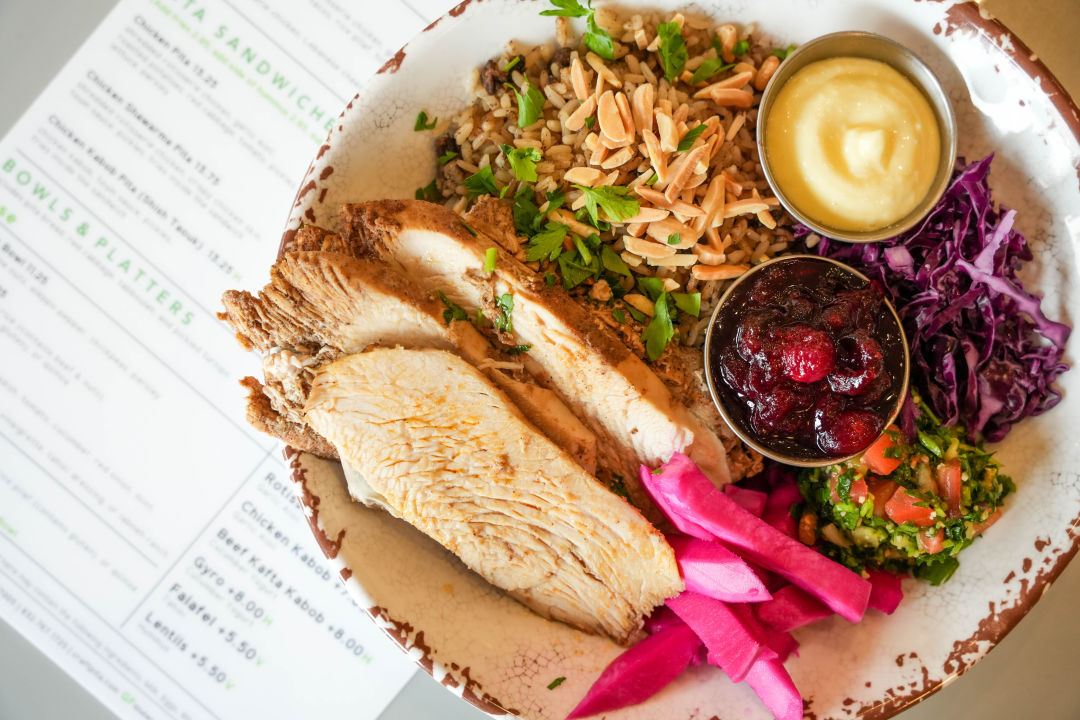At Houston Restaurants, Holiday Menus Celebrate Our Diverse Cultures

Image: Courtesy of Michael Ma
Lamb brings Rafael Nasr back to one of his fondest memories. One Christmas years ago, his grandma made it all the way over from Lebanon to America to celebrate the holiday with him and his family. This wasn’t common, because of the distance, and her visit became extra special when she realized they had cooked roasted lamb.
“Being able to have a bite from the homeland during the holidays—it can transport you,” Nasr says. “I remember [my grandma] crying about how proud she was that we were eating this Lebanese traditional lamb at Christmas.”
The holiday season is a time for gathering with family and eating food that reminds us of where we came from. In Houston, local restaurant owners are spreading holiday cheer by offering menus that reflect their heritage. At his restaurant Craft Pita, which has two locations in West University and Briargrove, Nasr will be serving a lamb shawarma, a nod to that special moment with his Lebanese grandma. His mom’s side of the family is from Peru, where turkey is traditionally eaten during Christmas time, so Craft Pita will also have roasted turkey as an option.
“This is a kind of nice combination of my two cultures,” Nasr says. “The Lebanese culture is all about family, food, and getting people together, and if we can be a part of that in any way shape or form, for us, it’s a pleasure during the holidays.”
Nasr pays special attention to his sides, too. Riz a djej, a spiced Lebanese rice typically made with nuts and chicken, is one of the most requested dishes by his family and friends during the holidays. Craft Pita will have this available to order alongside the lamb or turkey.
Everyone’s holiday feast looks different, and Houstonians are spoiled for choice when trying to find a slice of their homeland (or someone else’s). Picos, a Mexican restaurant in Upper Kirby that celebrated its 40th anniversary this year, held its 12 Days of Mole celebration in early December, a tradition that owner Arnaldo Richards began 14 years ago. A new mole was added to the menu every day, and on the 12th day, a brunch buffet was served with all them. If you missed this, don’t worry, as the moles are on offer until January 6.

Image: Courtesy of Picos
For Richards’s family, mole is a reflection of the holiday season, one he wanted to share with his customers at Picos. The event also serves as a way to educate people who may not be familiar with the sauce. Richards notes that not all moles are made with chocolate, for example. Different recipes emphasize chiles like ancho, guajillo, and chipotle, as well as tomatoes and tomatillos, nuts and seeds, and dried fruit. Only two moles at Picos are made with chocolate: the mole negro and mole poblano, also known as mole rojo. Each sauce combines nearly 30 ingredients and must be blended very carefully for the perfect fusion, he says.
“There’s a saying in Puebla that there are as many recipes of mole poblano as there are households in Puebla, because everybody makes it a little different,” Richards says.
The states of Puebla and Oaxaca claim to be the origin for mole. From the Oaxacan side, the menu at Picos also features mancha manteles, which is primarily made with peanuts as its thickening agent and typically includes ancho chiles, chicken, pork, pineapples, and plantains. Richards says this mole has a nice blend of the crunch of the pineapple and the softness of the plantains. Picos also offers pipian rojo and verde, mole Azteca, mole almendrado, mole miahuateco, mole de ciruela, and mole huitlacoche.
Of course, it wouldn’t be the holiday season without tamales. This year, Picos is once again selling a wide variety by the half dozen and dozen for takeout, including Norteños-style (in corn husks) and Oaxaqueños-style (wrapped in banana leaves). Cochinita & Co. in the East End is another local favorite for tamales, offering fillings such as pork in red adobo, chicken in roasted tomatillo sauce, roasted poblano peppers and panela cheese, and black bean and epazote. You know the saying: As long as you have tamales, you’ll always have something to unwrap on Christmas morning.
Cristina Benitez, owner of Café Piquet in Bellaire, says that while many Cubans have adapted for the most part to American culture, food is the one thing that binds everyone together as a way to embrace their roots—especially during the holidays. The restaurant’s Cena Navideña menu includes a traditional Cuban pork leg in garlic sauce, served with white rice, black beans, and sweet plantains.
Over at Southern restaurant Lucille’s in Midtown, family is at the center, too. Chef-owner Chris Williams’s great-grandmother, Lucille B. Smith, ran a catering business in Fort Worth, where she sold her Lucille’s All Purpose Hot Roll Mix. The product was one of the first packaged hot roll mixes to hit the market and was even enjoyed by historical figures such as Martin Luther King Jr., boxer Joe Louis, and First Lady Eleanor Roosevelt. Williams continues his great-grandmother’s legacy by selling the hot rolls all year long at her namesake restaurant. To round out your Christmas feast, make sure to order Lucille’s Southern classics like mac and cheese, braised collard greens, and twice-baked sweet potato.
The holiday season isn’t all about Christmas, of course, which is why Sof Hospitality is here to help Houstonians celebrate Hanukkah. Get your sufganiyots by the dozen or half dozen at Badolina Bakery in Rice Village. Similar to a doughnut, they’re filled with strawberry jam, pistachio paste, or vanilla, with some powdered sugar on top. Or venture over to Hamsa next door to buy some latkes to accompany your holiday feast and menorah lighting.

These treats take Yotam Dolev, the hospitality group’s culinary director, back to his childhood and remind him of his mother and grandmother. When he was growing up in Israel, the first night of lighting the candle for Hanukkah was a whole event. To celebrate, his family invited guests over who brought traditional sufganiyots, while his mom baked some filled with yogurt. Then, every night while lighting the menorah, his family ate latkes either as a starter for dinner, or they would pair it with a sweet apple pie for dessert.
“In Israel, you have a whole unspoken competition on who makes the best looking sufganiyots with cool toppings and new flavors every year,” Dolev says. “It’s really fun this time of year in Israel.”




